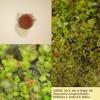
17-08-2018 21:50
Georges GreiffHello, Today, on two Fraxineus trees about 100m a

16-08-2018 16:08
 Blasco Rafael
Blasco Rafael
Hola, he recogido esta muestra sobre tronco de Abi

15-08-2018 15:45
Gernot FriebesHi,we collected this Scutellinia a few days ago on

12-08-2018 10:01
Tapio KekkiThese were growing on gravel of a creek. Place is

11-08-2018 01:19
 Matthias Mann
Matthias Mann
Dear Specialists, on Alnus Stem I found Chlotoci

06-08-2018 18:31
 Blasco Rafael
Blasco Rafael
Hola , He recogido lo que creo es una Encoelia, es

31-07-2018 19:34
 Andgelo Mombert
Andgelo Mombert
Bonsoir,Sur feuilles mortes de poacées, en zone s
Bryocentria octosporelloides literature request
Georges Greiff,
17-08-2018 21:50
Hello,
Today, on two Fraxineus trees about 100m apart, colonies of the leafy liverwort Cololejeunea minutissima were found to be parasitised by many tiny orange perithecia in the Nectria group. Upon microscopical examination these appear to fit the recently described species Bryocentria octosporelloides, which seems to have only been seen in Spain (as of April 2018).
If anybody could provide me with the recent paper to check my findings I would greatly appreciate it. It can be found at the following link if signed up to ascomycete.org
Thank you.
Georges R L Greiff

